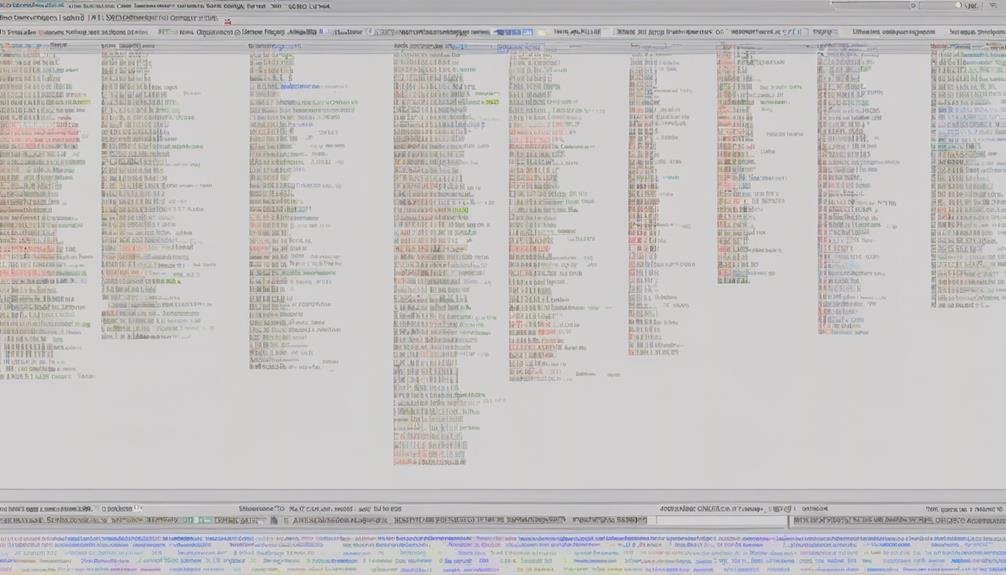To guarantee the security of your EVM contracts, follow best practices. Conduct smart contract audits to identify vulnerabilities and enhance security. Implement thorough testing, including edge cases, to detect bugs early and boost reliability. Use automated tools like Mythril and Oyente for vulnerability detection. Secure access controls with role-based authentication and monitoring. Implement fail-safe measures like circuit breakers for swift breach response. Utilize tools such as Octopus for detailed analysis. Code reviews enhance security, while gas optimization and compliance adherence improve performance and credibility. Safeguard your contracts with these proven measures for strong protection and reliability.
Table of Contents
Brief Overview of Security Best Practices For EVM Contracts
- Smart contract audits identify and mitigate vulnerabilities.
- Rigorous testing ensures functionality and security.
- Automated tools like Mythril enhance vulnerability detection.
- Secure access controls prevent unauthorized access.
- Gas optimization techniques improve contract performance.
Smart Contract Audits
Smart contract audits, essential for ensuring the robust security of Ethereum Virtual Machine (EVM) contracts, play an important role in identifying and mitigating potential vulnerabilities. These audits are critical in blockchain development, especially concerning decentralized applications (dApps) where trust and security are paramount. By subjecting smart contracts to thorough scrutiny, auditors can pinpoint common smart contract security vulnerabilities that malicious actors could exploit. The audits provide a detailed code analysis, highlighting security risks and deviations from best practices. Through meticulous code review, auditors can offer recommendations for improving the overall security posture of the smart contract.
Regular audits serve as a proactive measure to fortify the integrity of the smart contract ecosystem, preempting financial losses and reputational damage. By adhering to the best practices outlined in audit reports, developers can bolster the security of their EVM contracts, instilling confidence in the reliability and trustworthiness of the decentralized applications they underpin.
Rigorous Testing Procedures

Thorough testing procedures are essential in ensuring the reliability and security of smart contracts. Test coverage importance, automated testing tools, and manual testing considerations play key roles in this process. By focusing on these points, developers can strengthen the robustness of their smart contracts and mitigate potential risks effectively.
Test Coverage Importance
Ensuring thorough test coverage is paramount for evaluating the functionality and security of EVM contracts. Rigorous testing procedures encompass examining edge cases, running tests on various test networks like Rinkeby and Kovan, and achieving high test coverage to detect bugs and vulnerabilities early on. Extensive test coverage helps identify issues and increases confidence in the reliability and security of EVM contracts.
By thoroughly testing different scenarios, developers can enhance the robustness of their contracts, reducing vulnerabilities and ensuring smooth operation in real-world conditions. Prioritizing test coverage is fundamental for maintaining the integrity of smart contracts and safeguarding them against potential risks and vulnerabilities.
Automated Testing Tools
Utilizing automated testing tools is essential for thoroughly evaluating the security and functionality of EVM contracts. Tools like Mythril, Oyente, and Security play a vital role in identifying vulnerabilities within smart contracts. These automated tools employ advanced techniques such as taint analysis, symbolic execution, and static analysis to detect potential security issues effectively.
By conducting rigorous testing procedures with these automated tools, developers can guarantee the integrity and reliability of their EVM contracts. The reports generated by these tools provide accurate insights into the security posture of the contracts, enabling developers to address any vulnerabilities proactively. Leveraging automated testing tools enhances the overall security of EVM contracts, reducing the risk of exploitation and safeguarding the ecosystem.
Manual Testing Considerations
Manual testing is essential in ensuring EVM contracts’ robust security and reliability through meticulous examination of contract functionalities and potential vulnerabilities. When conducting manual testing for EVM contracts, developers should consider various aspects to enhance security and detect flaws effectively:
- Exploring Edge Cases: Testing extreme scenarios to uncover vulnerabilities.
- Analyzing Attack Vectors: Identifying potential ways malicious actors might exploit the contract.
- Detecting Logic Errors: Checking for inconsistencies or mistakes in the contract’s logic.
- Simulating Real-World Interactions: Mimicking how users would interact with the contract in practical situations.
- Testing Malicious Inputs: Validating the contract’s response to intentionally harmful data to prevent exploitation.
Secure Access Control Mechanisms

Implementing robust access control mechanisms in EVM contracts is vital for safeguarding against unauthorized access and manipulation of contract functions. Role-based access control is a fundamental aspect of secure access control, as it assigns specific permissions to different roles within the contract. By limiting actions to only authorized users, this method greatly enhances security. Additionally, incorporating multi-factor authentication adds an extra layer of protection by requiring multiple verification forms before granting access to sensitive functions.
It is important to stay proactive in maintaining security by regularly updating access control mechanisms to address new vulnerabilities and maintain a strong security posture. Moreover, monitoring access logs for suspicious activities or unauthorized changes is critical for promptly detecting and responding to potential security breaches in smart contracts. By implementing these secure access control measures, EVM contracts can better protect themselves against unauthorized access and manipulation, enhancing overall security and trust in the system.
Implementing Fail-Safe Protection
Fail-safe protection mechanisms play an important role in smart contracts by mitigating risks and minimizing potential damage from security breaches. To implement fail-safe mechanisms effectively and protect the contract, several strategies can be employed:
- Circuit breakers: Halt contract functionality in emergencies to prevent further vulnerabilities.
- Rate limits: Set controls to manage the frequency of actions, safeguarding the contract from abuse.
- Emergency withdrawal functions: Enable users to retrieve funds in unforeseen events or vulnerabilities.
- Pause functions: Temporarily stop contract operations to address security concerns before resuming.
- Fail-safe protocols: Establish procedures that outline steps to follow in case of security breaches, ensuring a swift response to mitigate risks and limit potential damage.
Utilizing Security Tools
Using advanced security tools can greatly enhance the analysis and detection of vulnerabilities in smart contracts bytecode. Smart Contract Security Tools such as Octopus, Oyente, Mythril, and Securify play a pivotal role in ensuring the robustness of blockchain platforms. Octopus stands out for its thorough analysis of the internal behaviors of smart contracts and their compatibility with various blockchain platforms.
Oyente, an automated audit tool, specializes in identifying common security vulnerabilities in smart contracts. Mythril, developed by ConSensys, focuses primarily on Ethereum security and employs advanced techniques like taint analysis and symbolic execution to uncover potential threats. On the other hand, Securify, supported by the Ethereum Foundation, utilizes context-specific static analysis to detect up to 37 different smart contract vulnerabilities.
By leveraging these sophisticated tools, developers can proactively identify and rectify security flaws, thereby fortifying the integrity and reliability of their smart contracts on blockchain platforms.
Conducting Code Reviews

Conducting thorough code reviews is essential for identifying vulnerabilities and ensuring the integrity of EVM contracts. When securing EVM contracts, engaging in meticulous code reviews is important in upholding best practices and coding standards. Here are five key reasons why code reviews are paramount in the domain of smart contract development:
- Peer reviews provide an opportunity to catch errors, logic flaws, and potential exploits within the smart contract code.
- Regular code reviews help identify security issues and vulnerabilities that could compromise the contract’s functionality.
- Adhering to coding standards through code reviews ensures consistency and readability in the codebase, making maintenance easier.
- Code reviews foster collaboration among team members, enabling knowledge-sharing and collective problem-solving.
- By promoting a culture of code reviews, teams can enhance the overall security and quality of their EVM contracts, mitigating risks and fortifying the contracts against potential threats.
Gas Optimization Techniques

To enhance the efficiency and cost-effectiveness of EVM contracts, implementing gas optimization techniques is essential for reducing computational overhead during contract execution. Gas optimization techniques focus on minimizing the computational effort required for executing EVM operations. This can be achieved by reducing conditional statements and utilizing in-memory computations to optimize gas usage within smart contracts.
By developing efficient and gas-friendly code, not only is cost-effective execution facilitated, but overall contract performance is also enhanced. Monitoring gas usage metrics is important in identifying areas where gas optimization can be implemented to improve contract logic and algorithms. Optimizing contract logic leads to faster and more efficient execution on the Ethereum blockchain, contributing to the overall success of the smart contract.
By prioritizing gas optimization techniques, developers can guarantee the efficient execution of EVM contracts while maximizing cost-effectiveness and performance.
Ensuring Compliance and Regulatory Adherence
Ensuring compliance and regulatory adherence in smart contract development involves understanding legal requirements, embracing regulatory frameworks, and implementing robust monitoring strategies. Developers can confidently navigate the complex landscape of smart contract governance by providing an overview of legal obligations, essential regulatory frameworks, and efficient compliance monitoring. These steps are pivotal in fostering trust, transparency, and accountability within the ecosystem, ultimately safeguarding both users and the integrity of the contracts.
Legal Requirements Overview
How do legal requirements guarantee data privacy and contract governance in smart contracts? Compliance with legal standards is essential for protecting sensitive data and ensuring the proper functioning of contracts. Here are five key aspects to take into account:
- Financial Regulations: Adhering to financial laws is important for smart contracts’ transparent and secure operation.
- Anti-Money Laundering (AML) Laws: Following AML regulations helps prevent illicit activities and maintains the integrity of transactions.
- Consumer Protection Statutes: Complying with consumer protection laws safeguards the rights and interests of users engaging in smart contracts.
- Legal Risks: Understanding and mitigating legal risks associated with non-compliance is crucial for the longevity of smart contracts.
- Evolving Legal Frameworks: Staying informed about changing legal landscapes ensures ongoing compliance with regulations.
Regulatory Framework Essentials
Compliance with regulatory frameworks is vital for maintaining integrity and trust within the smart contract ecosystem. Adhering to these regulatory standards guarantees legal requirements are met, enhances transparency, protects user data, and mitigates potential legal issues. By following regulatory frameworks, blockchain projects can safeguard their reputation and create a sustainable environment for growth.
Understanding and implementing these guidelines are essential for smart contract development’s long-term success and viability. Regulatory adherence is a foundation for building credibility and fostering stakeholder trust. Hence, incorporating regulatory essentials into blockchain projects is key to establishing a robust framework that upholds legal standards and promotes a secure and reliable ecosystem.
Compliance Monitoring Strategies
Thorough monitoring strategies are essential in maintaining legal and regulatory adherence in smart contract development. To guarantee compliance and regulatory adherence, consider the following strategies:
- Conduct regular audits to detect and address potential compliance issues promptly.
- Enhance trust and confidence by prioritizing data privacy and robust contract governance.
- Implement documentation practices and focus on code readability for effective compliance tracking.
- Adhere to regulatory standards through continuous monitoring of smart contract operations.
- Mitigate risks by establishing all-encompassing compliance monitoring frameworks.
Frequently Asked Questions
Why Is Smart Contract Security Important?
Smart contract security is of paramount importance in the blockchain ecosystem. Ensuring security measures protect assets from vulnerabilities and risks of compromise. It upholds decentralized applications’ integrity, trust, and assurance, safeguarding against financial losses and reputation damage.
Why Is EVM Compatibility Important?
EVM compatibility is crucial for smooth shifts, network integration, and interoperability in decentralized applications. It aligns protocols, optimizes code, standardizes token interactions, and enables cross-chain functionality, fostering flexible and secure smart contract development.
How Do You Ensure the Security and Robustness of Smart Contracts, and What Are Some Best Practices You Follow?
To guarantee the security and robustness of smart contracts, utilize code reviews, automated testing, security audits, gas optimization, error handling, input validation, dependency management, upgradability testing, penetration testing, and documentation updates. These practices strengthen contract integrity and reliability.
What Are the Considerations for Smart Contract Security?
Considerations for smart contract security encompass code review, penetration testing, vulnerability assessment, threat modeling, secure coding, risk assessment, attack surface analysis, security audits, secure deployment, and secure architecture. These practices are crucial for robust security measures.
Conclusion
Securing EVM contracts is similar to strengthening a castle against potential invaders. Developers can safeguard their contracts from vulnerabilities and guarantee their integrity by implementing best practices such as smart contract audits, rigorous testing procedures, and fail-safe protection. Utilizing security tools, conducting code reviews, and optimizing gas usage are essential strategies to enhance the security of EVM contracts. Compliance and regulatory adherence serve as the final layer of defense, ensuring a robust and resilient framework.




